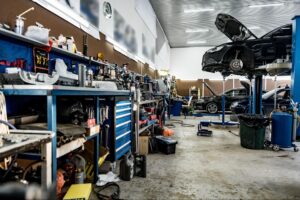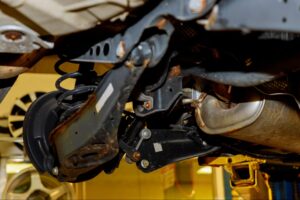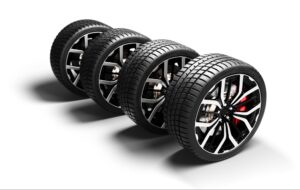
The Ultimate Auto Maintenance Checklist for Every Driver
Car troubles rarely appear without warning. They begin as minor issues that, if ignored, grow into costly repairs. Many drivers experience sudden breakdowns simply because they missed basic upkeep. Maintaining your vehicle protects your safety, preserves value, and saves you from unexpected expenses. Every journey becomes smoother when your car is cared for with consistency and attention to detail.
Why an Auto Maintenance Checklist Matters
An auto maintenance checklist organizes and tracks every critical service. Without one, it’s easy to forget inspections or replacements that protect your car’s safety and performance. A checklist also helps spot patterns, such as recurring issues or parts wearing faster than expected. This proactive approach reduces repair costs, prevents roadside breakdowns, and extends the vehicle’s lifespan. Maintaining a clear, consistent checklist is one of the smartest habits for drivers who want reliability and peace of mind.
Complete Auto Maintenance Checklist for All Drivers
Every car benefits from steady attention to its key systems. Regularly performing small maintenance tasks prevents costly breakdowns later. Drivers who stay consistent enjoy smoother rides and greater safety. A clear plan for upkeep turns routine care into long-term protection for your vehicle.
Check Safety and Reliability Systems
A dependable vehicle starts with attention to the systems that protect you on the road. Mechanical failures don’t appear overnight; they develop over time through missed inspections and skipped services. Addressing minor problems before they grow keeps your vehicle responsive and secure in all driving conditions. Safety-focused maintenance also boosts performance and reduces long-term repair expenses.
Brake System Checks for Safer Driving
Brakes work by converting motion into heat, slowing the vehicle quickly. Worn brake pads or damaged rotors lengthen stopping distances, making accidents more likely. Inspect your brakes twice yearly, checking pads, rotors, and brake fluid. Grinding noises, squeals, or a soft pedal mean immediate service is needed. Addressing issues early prevents damage to calipers and other expensive parts. Consistent brake care ensures you can stop safely every time.
Tire Inspections and Regular Rotations
Tires connect your car to the road and control grip. Low tread or uneven wear affects handling, braking, and fuel efficiency. Check tire pressure monthly and adjust for seasonal changes. Rotate tires every 5,000–7,500 miles to extend lifespan and prevent irregular wear. Keeping tires in good shape reduces blowout risks and improves ride comfort. Balanced, inflated tires also make your car run more efficiently.
Maintaining Lights and Signal Systems
Vehicle lights keep you visible and help you communicate with other road users. Dim or flickering bulbs can cause misjudgments from other drivers. Inspect headlights, brake lights, and turn signals every few weeks. Replace faulty bulbs promptly and clean lenses for better brightness. Electrical checks can detect wiring issues before they become safety hazards. Well-maintained lighting protects you in both day and night driving.
Protect Engine Performance and Longevity
Engine performance relies on regular inspections and timely replacement of parts. Dirt, heat, and friction can damage critical components without proper upkeep. A well-maintained engine runs efficiently, lasts longer, and uses less fuel. Skipping services risks sudden breakdowns and higher long-term costs.
Oil and Filter Changes for Engine Protection
Oil lubricates moving engine parts, reducing friction and preventing damage to the engine. Over time, oil collects dirt and loses effectiveness. Change your oil and filter according to the manufacturer’s schedule, usually every 5,000–7,500 miles. Use the correct oil grade for your region’s climate to maintain performance. Skipping changes can lead to sludge buildup and engine failure. Clean oil improves efficiency and reduces repair costs.

Air and Cabin Filter Replacement
Air filters keep dust and debris out of the engine, while cabin filters clean the air you breathe. A clogged air filter reduces power and fuel efficiency. Replace it every 12,000–15,000 miles or sooner in dusty conditions. Cabin filters should be swapped at similar intervals for better air quality. Neglecting them strains the engine and HVAC system, making both less effective. Fresh filters maintain peak performance and comfort.
Cooling System and Radiator Checks
Your cooling system prevents overheating by circulating coolant through the engine. Low coolant or blocked flow can cause severe damage. Check coolant levels regularly and inspect hoses for cracks or leaks. Follow your vehicle’s maintenance schedule to flush the system. A healthy cooling system maintains a stable temperature in all driving conditions. Ignoring this system can lead to costly engine repairs.
Timing Belt or Chain Maintenance
The timing belt or chain synchronizes the engine’s internal movement. If it fails, it can cause severe engine damage instantly. Inspect it regularly and replace it at the recommended mileage, often between 60,000 and 100,000 miles. Signs of trouble include ticking noises or starting issues. Having a mechanic check this during service can prevent catastrophic failures. This single maintenance step can save thousands in repairs.
Inspect Battery and Electrical Systems
A strong electrical system keeps your car starting reliably and powers essential features. Weak batteries, failing alternators, or corroded wiring can lead to sudden breakdowns. Checking these systems regularly avoids unexpected interruptions and expensive tow bills. Healthy electrics also improve performance across other vehicle systems.
Battery Testing and Cleaning
Your battery provides the power to start your engine and run electronics when the engine is off. Test it twice yearly, especially before extreme heat or cold. Clean any corrosion from the terminals using a baking soda solution. Batteries typically last three to five years, so watch for signs of slow starting or dim lights. Replace before failure to avoid being stranded. A fresh battery keeps your car dependable year-round.
Alternator and Starter Performance
The alternator charges your battery while the engine runs. If it fails, the car will quickly lose electrical power. Dimming headlights or whining noises may mean alternator trouble. When you turn the key, the starter cranks the engine; clicking or slow cranking can tell it’s failing. Testing these components during service prevents breakdowns. Timely replacement keeps your electrical system working as intended.
Inspecting Fuses and Wiring
Fuses protect electrical systems from overload. A blown fuse can shut off important features, such as lights or wipers. Check your fuse box if something stops working, and replace blown fuses with the correct type. Examine wiring for fraying or exposed metal, which can cause shorts or fires. Securing connections and replacing damaged wires enhances safety. Regular checks help prevent electrical malfunctions that could impact driving.

Check Fluid Levels and Filter Conditions
Fluids are the lifeblood of your car’s systems. They lubricate, cool, and power different components. Neglecting them can lead to overheating, corrosion, and expensive repairs. Monitoring levels and replacing fluids on time preserves system performance.
Transmission Fluid for Smooth Shifting
Transmission fluid lubricates gears and keeps the system running smoothly. Check levels monthly and look for discoloration or a burnt smell. Replace the fluid according to the manufacturer’s guidelines, typically every 30,000–60,000 miles. Old or contaminated fluid can cause hard shifting or transmission failure. Always use the specified type for your vehicle. Clean fluid ensures smooth and responsive gear changes.
Brake Fluid Maintenance
Brake fluid carries the force from your pedal to the brakes themselves. Over time, it absorbs moisture, reducing braking power. Flush and replace it every two to three years or if it looks dark. A spongy pedal often means the fluid needs attention. Fresh brake fluid improves stopping consistency and reliability. This simple service greatly enhances road safety.
Power Steering Fluid Checks
Power steering fluid helps you turn the wheel without effort. Low fluid causes stiffness or whining noises while steering. Check levels regularly and top up as needed. Look for leaks that could drain the system. Replace the fluid at intervals recommended by the manufacturer. Smooth steering makes driving more comfortable and safer.
Prepare for Seasonal Driving Conditions
Weather affects your car’s performance and the strain its systems endure. Preparing your vehicle for temperature shifts ensures it remains safe and comfortable year-round. Seasonal maintenance also extends the lifespan of parts prone to weather-related wear. Adapting your checklist to the season ensures reliability in any climate.
Winter Auto Maintenance Essentials
Cold weather can make starting difficult and thicken fluids. Test your battery capacity before winter begins. Switch to winter-grade oil if your car’s manual recommends it. Check antifreeze levels and strength to prevent freezing. Install winter tires for better grip on snow and ice. Top up washer fluid with a freeze-resistant formula to maintain visibility.
Summer Auto Maintenance Tips
Hot temperatures stress the cooling system and other components. Inspect the radiator and coolant before peak heat arrives. Test the air conditioning for strong airflow and cold output. Monitor tire pressure more often, as heat increases air expansion. Check all fluid levels regularly, as some may evaporate faster in summer. Preventive care avoids heat-related breakdowns during travel.
Preparing for Rainy Weather
Wet roads reduce traction and visibility. Replace worn wiper blades and check their sweep for streaks. Ensure tires have enough tread to resist hydroplaning; test defrosters to clear windows during rain. Adjust headlights for proper aim and brightness. These steps enhance safety in conditions of heavy rainfall and poor visibility.
Keep Detailed Maintenance Records
Maintaining detailed records protects your investment and supports informed decision-making. Providing consistent care also increases your vehicle’s resale value. Organized records reduce the chance of missed services and surprise repairs. They give a clear history that mechanics and future buyers can trust.
Creating and Updating Service Logs
Track every oil change, filter replacement, and inspection in one place. You can use a physical notebook, a spreadsheet, or a mobile app. Reviewing this history helps spot patterns in wear and performance. Mechanics can recommend services more accurately when they see the record. A complete log makes your vehicle more attractive to buyers. Consistency in logging builds trust in the car’s condition.
Maintaining Warranty Compliance
Warranties require you to follow a set maintenance schedule. Missing required services can void coverage. Keep receipts or digital confirmations of all work done. If a warranty claim is challenged, these records protect your rights. Warranty compliance can save thousands in repair costs. Staying on schedule preserves both coverage and vehicle health.
Turn Auto Maintenance into Your Driving Advantage
Every mile on the road is an opportunity to protect your car’s performance and value. Consistent care and timely auto services keep your vehicle responsive, safe, and ready for any journey. Begin building your checklist today and follow it promptly. Taking a few intentional steps and scheduling regular services now can prevent costly problems later and keep you ahead of unexpected repairs.
Learn from the experts you trust. Read the Cordova Auto Service & Mufflers’ blog for practical advice and the latest auto-care solutions.




